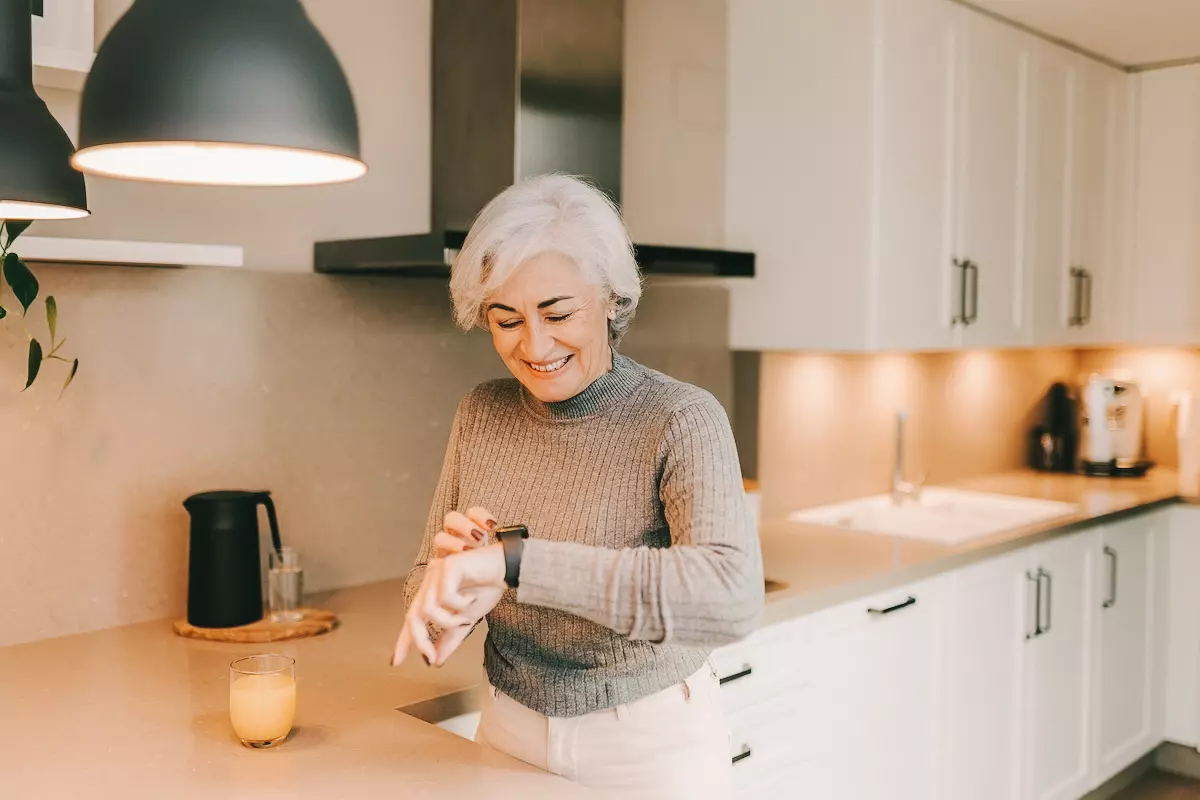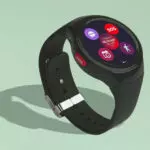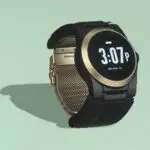Table of Contents
- Bay Alarm Medical’s SOS Smartwatch is our top pick as the medical alert watch with the easiest setup, great features for active users, and light and comfortable design.
- A medical alert watch provides individuals with peace of mind and safety by offering features such as emergency call buttons, fall detection, heart rate monitoring, and medication reminders. These features ensure prompt assistance during emergencies and overall health management.
- Our team spent over 6,000 hours researching, hand-testing 23 devices, and consulting with 10 experts to select the top three best medical alert watches.
Even if you realize the benefits of having quick, 24/7 access to emergency assistance after a recent injury or lifestyle change, you still may not feel ready to wear a traditional medical alert necklace. Although medical alert necklaces have grown more discreet in the past few years, they still look and feel more obvious than some alternatives, like medical alert watches.
The best medical alert watches resemble smartwatches, but they work the same way as most medical alert systems. You just press a button to connect to a 24/7 monitoring center and speak with the operator straight from your device. Having a trained operator available at all times from your medical alert watch can offer you and your caregivers a sense of security without exchanging comfort and discretion for protection.
And with a medical alert watch, there’s no need to worry about a smartphone. Unlike Apple Watch and other popular smartwatches, the best medical alert watches don’t require a smartphone.
“Medical alert watches can be very effective in enhancing the wearer’s safety,” says Raj Dasgupta, chief medical advisor for Sleep Advisor. “They provide quick access to help in an emergency, reduce the risk of falls, improve medication adherence, and provide peace of mind.”
After testing six medical alert watches, the Handbook Team narrowed the list to our top three picks.
3 Best medical alert watches
- Best for active users: Bay Alarm Medical SOS Smartwatch
- Best for extra features: Medical Guardian MGMove
- Best for custom fall detection: UnaliWear Kanega Watch
What you need to know about our medical alert watches
Here are five things you should know about medical alert watches.
Compare the best medical alert watches of 2024
| Starting monthly price | $34.95 | $39.95 | $69.95 |
| One-time equipment fee or activation fee | $159 | $199.95 | $299 |
| Fall detection | Yes, $10 per month | Yes, $10 per month | Yes, included |
| Average response time (seconds) | 58 | 50 | 66 |
| Battery life (hours) | 6–18 | 24 | 24–36 |
The best medical alert watch reviews
1. Bay Alarm Medical SOS Smartwatch: Best for active wearers
Why we chose Bay Alarm Medical as best for active wearers
With its accurate GPS location tracking, step tracker, detailed weather app, and comfortable fit, the Bay Alarm Medical SOS Smartwatch is great for active wearers looking for discreet protection.
Setting up the smartwatch was simple with the help of step-by-step instructions. We liked that our first step was saving the monitoring center phone numbers (this came in handy when a monitoring center call dropped). Bay Alarm Medical even provided detailed instructions on adjusting the watch band, saving us from trying to figure this out ourselves.
After slipping on the SOS Smartwatch and adjusting the band, we immediately noticed how light and comfortable it was. Like the MGMove, the SOS Smartwatch feels like a smartwatch, not a bulky medical alert system trying to pass as a smartwatch.
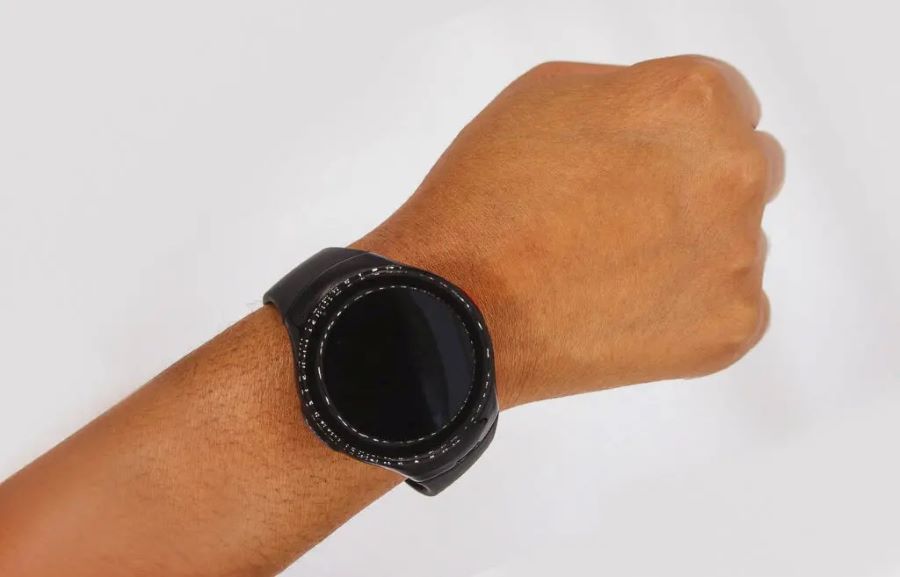
Some of our favorite SOS Smartwatch features:
- Choosing between an analog or digital clock display.
- The weather app is detailed and mimics what you’d see on your phone by displaying humidity, “feels like” temperature, and sunrise and sunset times.
- The charging cradle is magnetic, and the watch easily snaps into place.
- Verbal and visual cues to confirm charging.
It took us an average of 58 seconds to reach the monitoring center. We liked that the watch beeped every three seconds when we called, reassuring us that the call was going through.
Unfortunately, one of our monitoring center calls dropped during testing. The monitoring center called our cell phone to confirm if we needed assistance. While we appreciate the follow-up, emergency services could be dangerously delayed if a call drops and you’re not near your cell phone.
We were disappointed with the watch’s fall detection performance: It detected three out of six falls. Zero slow, gradual falls were detected, but the SOS Smartwatch did detect all three hard falls.
Every time the watch detected a fall, the watch face screen displayed, “Did you fall?” We like that there’s a chance to stop the call if fall detection is accidentally triggered—it’s less annoying than waiting to connect to the monitoring center to tell the agent it’s a false alarm. If you or your care recipient do fall and can’t confirm it with the “Yes” button, the watch automatically calls the monitoring center within 10 seconds.
Overall, we thought the SOS Smartwatch was intuitive and simple to navigate, but it did have some drawbacks:
- Short battery life.
- The speaker’s audio quality was slightly fuzzy when speaking with monitoring center agents.
- It was sometimes difficult to read the watch face screen in bright conditions, such as outside or near windows.
- After our hard fall detection tests, the watch face rim had light scuff marks.
The SOS Smartwatch connects to the free Bay Alarm Medical app and lets caregivers and users access the following:
- Monitoring center call logs.
- Real-time GPS location on Google Maps.
- Smartwatch battery level.
- Step counter and daily step goal.
- Cellular network connection status.
What our testers say:
“When testing the Bay Alarm Medical app, we could view a detailed log of past monitoring center calls. Each call log listed the monitoring center agent we spoke with and the date and time of the call.”
2. Medical Guardian MGMove: Best for extra features
Why we chose Medical Guardian as best for extra features
The Medical Guardian MGMove packs impressive smartwatch elements without being overwhelming. Chatting with caregivers straight from the watch is one of our favorite features. Luckily, we didn’t have to type our messages on the small screen—wearers can either record a voice message or convert the voice message to a text message. Unfortunately, this unique feature isn’t automatically included with your MGMove: It’s part of the Support Circle App for an extra $5 per month.
Not to be confused with the MyGuardian app, the Support Circle app refers to extra caregiver features for the MGMove. Users can also receive and manage daily task reminders and calendar events with the Support Circle add-on. Whether you’re a caregiver or a user, you can access all features in the online portal or MyGuardian app.
We were impressed with how comfortable this medical alert watch was—one tester said wearing the MGMove felt like wearing their day-to-day watch. The wristband material was smooth (it didn’t pinch our skin) and easy to adjust.
Other features we liked about the MGMove:
- Step tracker and weather app.
- Test call button to test the connection to the 24/7 monitoring center without making an emergency call.
- Magnetic charging cradle.
- Verbal and visual cues to confirm charging.
- Fastest response time: 50 seconds.
The touch screen is the only way to navigate the watch, which may be difficult or frustrating for some users. Pressing the “SOS” button at the top right of the home screen was hard. Sometimes when we touched this button, the watch thought we were trying to swipe to the next screen, which could be dangerous during an emergency.
Fortunately, a second SOS button is on the side of the watch face. We recommend pressing this button if you need to contact the monitoring center.
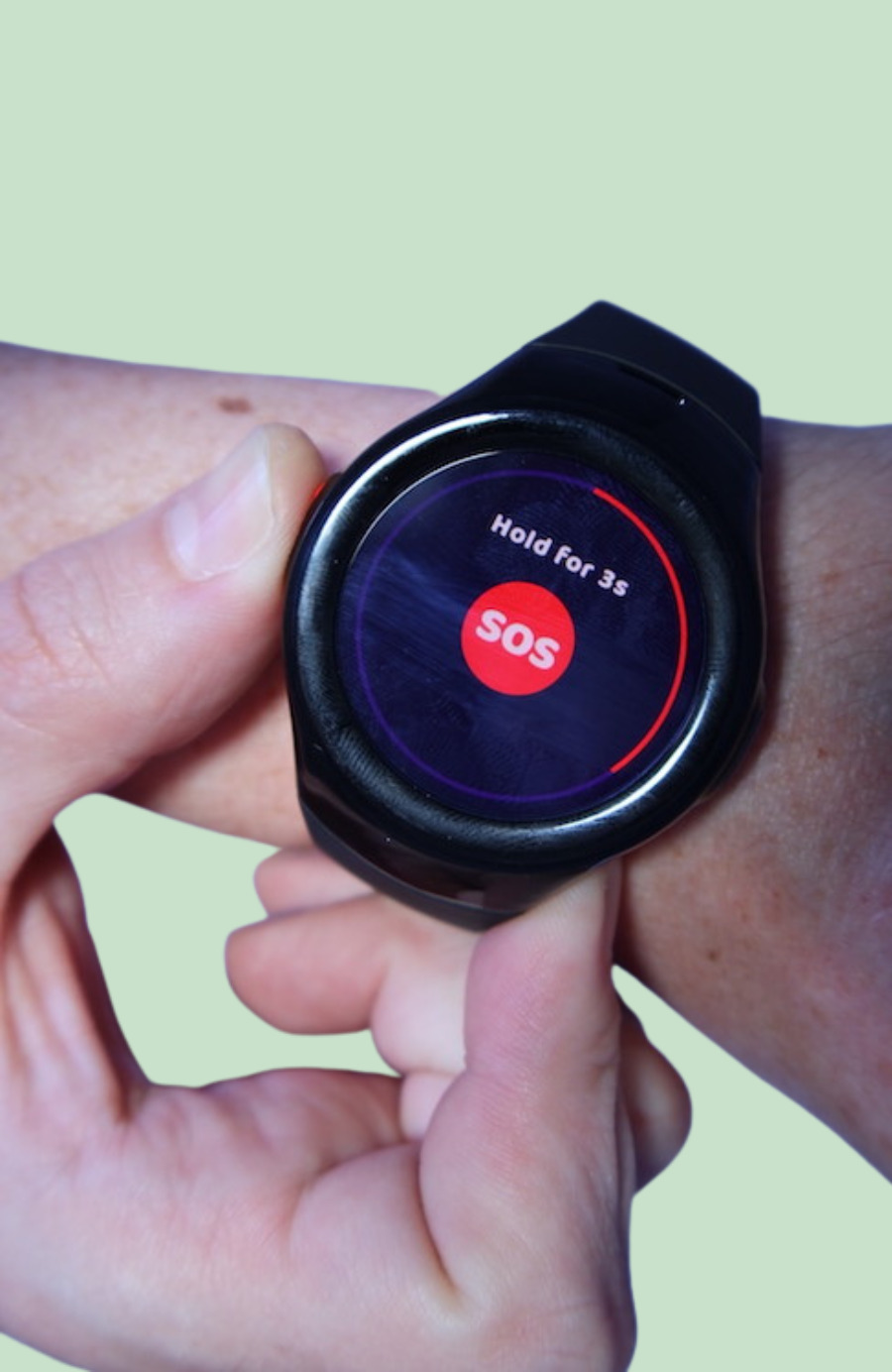
Other drawbacks of the MGMove:
- Inaccurate GPS location tracking.
- The watch face doesn’t display the battery level while wearing it.
What our testers say:
“The MyGuardian app shows the MGMove’s battery status, but you can’t check the battery status on the watch itself unless it’s in the charging dock.”
Features we could access in the MyGuardian app:
- View real-time GPS location on Google Maps.
- Smartwatch battery level.
- Step counter and daily step goal.
- Cellular network connection status.
- Emergency contact info and call order.
- Detailed health information about the user, such as walking gait, oxygen needs, and local hospital info.
The MGMove didn’t support fall detection when we originally tested it. The Handbook Team plans to test the smartwatch with fall detection and update our review with new fall detection data.
Read more in our in-depth Medical Guardian review.
3. UnaliWear Kanega Watch: Best for custom fall detection
Why we chose UnaliWear as best for custom fall detection
The UnaliWear Kanega Watch is the only medical alert watch on this list that allows you to adjust the fall detection sensitivity to fit your activity level. Unlike most medical alert watches, the fall detection algorithm isn’t stagnant—it’s based on real fall data from thousands of users and your individual movement.
We learned from customer service that fall detection sensitivity is set at UnaliWear’s recommended level when you receive your watch. If you want more or less fall detection sensitivity, a customer service representative can adjust it over the phone.
Our Kanega Watch’s fall detection sensitivity level was 25 when we received it (even though the default setting is 50), but we called customer service to change it to 10—a more sensitive setting—to better detect test falls. Fall detection sensitivity can be adjusted from 0 (most sensitive) to 100 (least sensitive).
After adjusting the watch’s fall detection sensitivity, we conducted our slow and fast test falls. The watch detected one slow fall and no fast falls. After speaking with a UnaliWear representative, we learned the Kanega Watch doesn’t detect falls when it’s not worn on the wrist. Although dropping a medical alert system from shoulder height is a common way to test fall detection, it wasn’t effective for testing if the Kanega Watch could detect fast falls.
The representative also told us that the watch’s fall detection algorithm is more sensitive to backward and sideways falls. We were impressed the Kanega Watch successfully detected all backward and sideway fall tests.
We wore the Kanega Watch for two days. At first, the watch felt heavy and bulky, but we forgot it was on our wrist by the second day. Unlike other medical alert watches, you don’t need to remove the Kanega Watch to charge it—it’s designed to be worn 24/7.
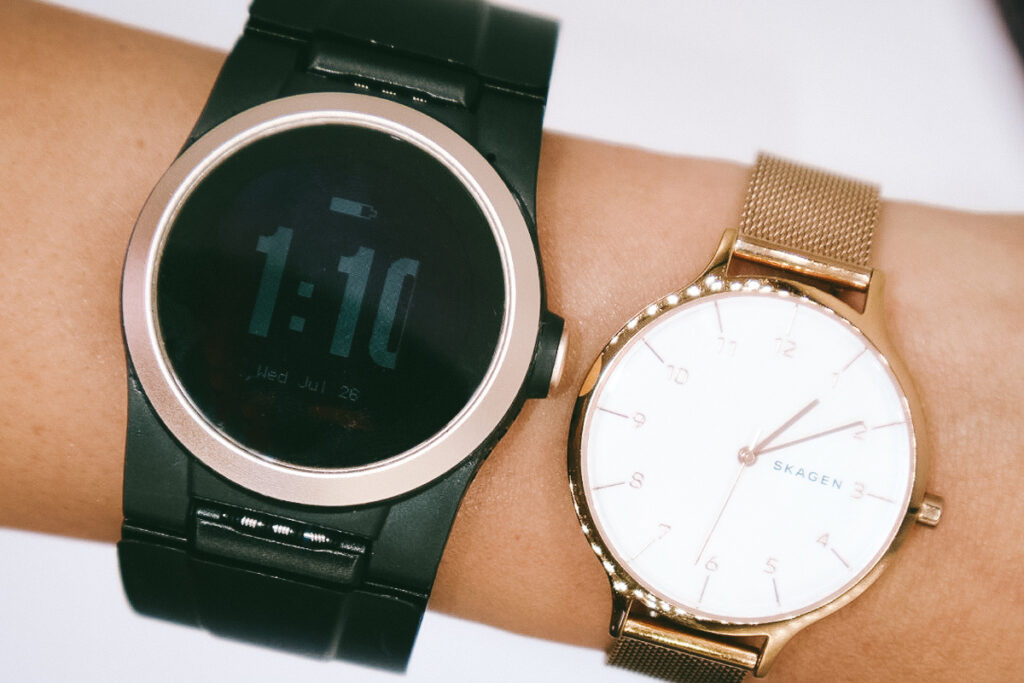
The watch includes four rechargeable batteries: Two batteries snap in the watchband while the other batteries charge.
This unique design makes the watchband heavier and bulkier than other smartwatches, but the perk of not having to remove the Kanega Watch to charge it may be worth it for many wearers.
Other features we liked:
- Voice activation to call the monitoring center and check the date and time.
- Can set up multiple medication reminders and choose verbal or text reminders.
- Large watch face with bright white text and black background.
What our testers say:
“The user guide did not include instructions on how to adjust the watch on your wrist. However, after going to the support link included on the front page of the user manual, I quickly found a video that showed me how to adjust it, and it was simple after that.”
UnaliWear encourages users to call customer service whenever they need to adjust the watch’s settings or have a troubleshooting question. If you prefer adjusting settings on your own, many features (besides fall detection sensitivity) can be controlled with the “Crown” button on the side of the watch face.
Some things we didn’t like about the Kanega Watch:
- The watch was bulky and heavy compared to other brands.
- Voice activation took multiple attempts to work.
- No caregiver app available.
- Step tracking not available.
- Longest monitoring center response time: more than one minute.
Pros and cons of medical alert watches
What we like about medical alert watches
- More discreet than medical alert necklaces.
- Can speak with monitoring agents through the two-way speaker.
- Optional fall detection is available for most watches.
- Many have extra features like step tracking, a weather app, and reminders.
What we don’t like about medical alert watches
- Fall detection may not be as accurate as medical alert necklaces.
- Battery life is shorter than mobile medical alert systems.
- The touch screen may be more difficult to navigate.
Some users like the sleek look of a touch screen, but others may find it harder to use. Nancy Mitchell, a registered nurse and geriatric director of care in Atlanta, says bone density decreases in the hands as we age, which may result in reduced motor skills and dexterity.
“The hands become weak when this happens, making it more difficult for older adults to press sufficiently on a screen to elicit any action from a smart device,” Mitchell says.
Handbook Team Tip #1
If you’re shopping for a medical alert watch for your care recipient, discuss different style options and features with them—don’t assume you know what they want. The more involved they are in choosing their watch, the more likely they’ll want to wear it.
How much do medical alert watches cost?
|
Bay Alarm Medical SOS Smartwatch
See Special Offers
|
Medical Guardian MGMove
See Special Offers
|
UnaliWear Kanega Watch
See Special Offers
|
|
|---|---|---|---|
| Starting Monthly Cost | $34.95 | $39.95 | $69.95 |
| One-Time Fee | $159 | $199.95 | $299 |
| Fall Detection (per year) | $599.40 | $439.44 | $779.40 |
Medical alert watch costs are broken down into two main fees: monthly monitoring and one-time equipment fees. While monthly monitoring costs usually range from $30–$50, smartwatch equipment fees are often more than $100.
- Bay Alarm Medical SOS Smartwatch has the lowest starting monthly fee ($34.95) and the lowest equipment fee ($159) out of the best medical alert watches.
When budgeting for your smartwatch, consider other possible fees on top of your monthly monitoring and equipment costs.
- Fall detection is an extra $10 per month with most watches. UnaliWear is the only brand that bundles fall detection with their monthly price.
- Additional features and accessories like reminders or a lockbox are often available for an additional monthly fee.
- A protection plan in case the smartwatch is damaged, stolen, or lost. Most plans cost less than $10 per month.
- Shipping costs range from $12–$15. Most brands waive shipping fees if you choose a quarterly or annual payment plan.
Here’s a look at the average monthly costs of medical alert watches so you can compare pricing:
- Highest starting price in the industry: $69.95
- Average industry-wide starting price: $44
- Lowest starting price in the industry: $29.95
Handbook Team Tip #2
Most medical alert system brands offer discounts with an annual payment plan, such as a free service month, waived shipping fees, or a free lockbox.
How to save money on medical alert watches
- Flexible spending accounts (FSA): These pre-tax funds are eligible to pay for medical alert watches. Since your FSA is connected to your employer, you can’t use it when you retire.
- Health savings accounts (HSA): You can’t add to your HSA once you’re enrolled in Medicare, but you can still use the funds to pay for a medical alert watch even after you’ve retired.
- Payment plan discounts: You may get a discount on your medical alert watch if you pay quarterly (four times a year) or annually (once a year) instead of month-to-month. Common deals are free shipping, a free month of service, or a discounted monthly monitoring fee.
- Seasonal discounts: Look for limited-time discounts throughout the year. Some brands offer discounts around holidays or events, such as Fall Prevention Awareness Month in September.
Handbook Team Tip #3
Original Medicare (Part A and B) doesn’t cover medical alert systems, but some Medicare Advantage (Part C) plans may offer partial or full coverage. Always check with your insurance provider since coverage varies by state and plan.
Key features to look for in medical alert watches
Fall detection
Many medical alert watches now offer fall detection, meaning the watch has a sensor that automatically contacts the monitoring center if it detects a fall. This is a crucial feature if you or your care recipient have a higher risk of falling or losing consciousness because of a health condition, limited mobility, medications, or other risks.
Fall detection doesn’t prevent falls, but receiving help less than an hour after a fall helps reduce the risk of future falls, reduced mobility, and pressure-related injuries.
Fast response times
Fast response times are necessary for fall detection monitors. The quicker the device detects the fall and sends an alert, the faster help can arrive. Response time includes the time it takes for the alert to reach the monitoring team and the time it takes for that team to contact local help.
GPS tracking
Many fall detectors include GPS tracking for added peace of mind. GPS tracking allows caregivers or emergency services to pinpoint the wearer’s location in the case of a fall, especially if it occurs outside of the home. Real-time location updates can help speed up rescue efforts.
Design and comfort
Comfort and ease of use are vital for long-term wearability. Fall detection monitors come in many designs, from discreet pendants to stylish necklaces. A comfortable device is one that’s more likely to be used.
Plus, clear displays with large, easy-to-read text are essential for older adults or those with visual impairments.
Battery Life
A reliable fall detection monitor will have ample battery life to avoid interruptions in protection. Extended battery life reduces times when the monitor may not be worn. Many devices also include low battery alerts to prevent unexpected powering down.
Handbook Team Tip #4
Since fall detection is not always 100 percent accurate, we encourage wearers to press the watch’s help button after a fall if possible.
Our medical alert watch testing experience




From the best medical alert systems to fall detection devices, we only recommend medical alert systems we’ve held in our hands, used, and tested.
Our team tested medical alert watches from the following six brands:
- Bay Alarm Medical
- HandsFree Health
- LifeFone
- Medical Care Alert
- Medical Guardian
- UnaliWear
Many medical alert watches are similar across brands, so we tried to highlight devices with a variety of features, prices, and safety features to help you choose the right one for you or your care recipient.
We followed this testing process for each smartwatch:
When wearing and testing each medical alert watch, we asked the following questions:
- Are there any problems when setting up the watch?
- How simple or difficult is it to navigate the device?
- Can monitoring center agents see our correct GPS location?
- Is the watch comfortable to wear? To sleep in?
- Did the watch initiate an emergency call when it shouldn’t have?
- Are there low battery alerts?
- Is it easy to place the device in the charging cradle?
- Does the watch alert you when it’s fully charged?
From one of our testers
“It was easy to snap the MGMove right into the magnetic charging dock, and we liked that the watch announced when it was fully charged.”
Our team also performs fall tests with medical alert watches offering fall detection (at the time of testing, Medical Guardian MGMove didn’t offer fall detection).
While research shows the best placement for accurate fall detection is on the chest or worn as a necklace, most medical alert watches offer optional fall detection. We definitely noticed a difference in fall detection accuracy when testing medical alert watches versus necklaces—the best medical alert necklaces had higher accuracy rates compared to medical alert watches.
Although we do our best to test each fall detection device accurately by simulating multiple falls, our fall detection testing isn’t 100 percent accurate. We’d need to record about 100,000 days of activity to create enough real-world fall data.
From one of our testers
“When testing fall detection, waiting 30 seconds before dropping the device helps the SOS Smartwatch calibrate and yield more accurate results.”
How we tested fall detection:
- Our team conducted three “slow” and three “fast” test falls while wearing the smartwatch. We started all slow falls by sitting in a chair at 90 degrees and dropping to our knees before falling face down on a mat.
- For the fast fall, we dropped the watch from shoulder height to the mat to replicate a fast, hard-impact fall.
UnaliWear Kanega Watch
The UnaliWear Kanega Watch didn’t detect our “fast fall” tests as actual falls since the watch is designed to only register falls when worn. Through testing, we learned that the Kanega Watch’s fall detection algorithm is more sensitive to backward and sideways falls.
There were only a couple of instances where our hand movements triggered a false fall detection alarm. We thought this would happen more throughout the day, especially since research warns that quick, jerky movement of arms and hands may be more likely to set off fall detection.
Our final verdict
We believe Bay Alarm Medical, Medical Guardian, and UnaliWear offer the best medical alert watches after wearing and testing six watches.
We recommend the Bay Alarm Medical SOS Smartwatch for active wearers who want a simple medical alert watch. The watch’s comfortable fit, step tracking, and weather app are useful tools on top of 24/7 monitoring without being overwhelming.
Medical Guardian MGMove is our top choice if you’re looking for a medical alert watch with extra features like caregiver chatting and calendar reminders. It also had the fastest average response time of the best medical alert watches.
The UnaliWear Kanega Watch is excellent for users needing more or less sensitive fall detection sensors. We like that the fall detection sensors are designed to learn what is and isn’t a fall based on the wearer’s daily movement. We also recommend this watch for those not comfortable using a touch screen.
The right medical alert watch for you or your care recipient depends on your budget, lifestyle, and how many (or how few) features you want.
Frequently asked questions
Original Medicare (Part A and B) doesn’t cover medical alert watches, but some Medicare Advantage (Part C) plans may cover costs. Coverage varies by insurance plan and state, so always check with your insurance provider.
Based on our testing, the Bay Alarm Medical SOS Smartwatch, Medical Guardian MGMove, and UnaliWear Kanega Watch are the best medical alert watches available today. The right watch for you or your care recipient depends on your budget, comfort with technology, preferences, care environment, and other considerations.
Yes, medical alert smartwatches connect to a 24/7 monitoring center during an emergency. Many medical alert watches have fall detection, GPS location tracking, step tracking, and even a weather app.
The Bay Alarm Medical SOS Smartwatch, Medical Guardian MGMove, and UnaliWear Kanega Watch are the best watches for detecting falls. Your ideal choice will depend on your budget, desired features, and preferences.
- Lee, Y., Pokharel, S., Muslim, A. A., KC, D. B., Lee, K. H., & Yeo, W.H. (2023). Experimental study: Deep learning-based fall monitoring among older adults with skin-wearable electronics. Sensors, 23(8), 3983. Link
- Lee, Y. (2023). Experimental Study: Deep Learning-Based Fall Monitoring among Older Adults with Skin-Wearable Electronics. Sensors, 23(8). Link
- Broadley, R., Klenk, J., Thies, S., Kenney, L., & Granat, M. (2018). Methods for the real-world evaluation of fall detection technology: A scoping review. Sensors, 18(7), 2060. Link
- González-Cañete, F. J., & Casilari, E. (2021). A feasibility study of the use of smartwatches in wearable fall detection systems. Sensors, 21(6), 2254. Link
- U.S. Department of Health and Human Services. (n.d.). Falls and fractures in older adults: Causes and prevention. National Institute on Aging. Link
- Blackburn, J., Ousey, K., Stephenson, J., & Lui, S. (2022). Exploring the impact of experiencing a long lie fall on physical and clinical outcomes in older people requiring an ambulance: A systematic review. International Emergency Nursing, 62, 101148. Link




